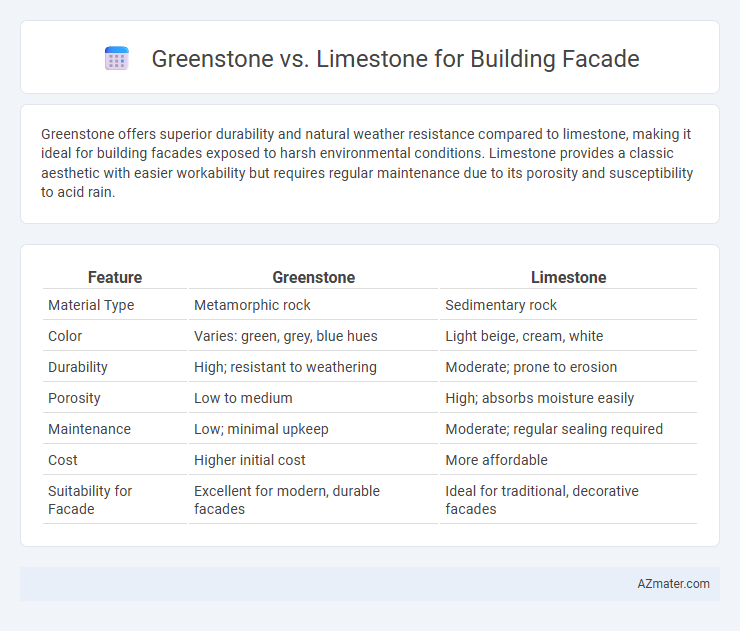Greenstone offers superior durability and natural weather resistance compared to limestone, making it ideal for building facades exposed to harsh environmental conditions. Limestone provides a classic aesthetic with easier workability but requires regular maintenance due to its porosity and susceptibility to acid rain.
Table of Comparison
| Feature | Greenstone | Limestone |
|---|---|---|
| Material Type | Metamorphic rock | Sedimentary rock |
| Color | Varies: green, grey, blue hues | Light beige, cream, white |
| Durability | High; resistant to weathering | Moderate; prone to erosion |
| Porosity | Low to medium | High; absorbs moisture easily |
| Maintenance | Low; minimal upkeep | Moderate; regular sealing required |
| Cost | Higher initial cost | More affordable |
| Suitability for Facade | Excellent for modern, durable facades | Ideal for traditional, decorative facades |
Introduction: Comparing Greenstone and Limestone for Facade Design
Greenstone and limestone are prominent choices for building facades, each offering distinct aesthetic and structural qualities. Greenstone provides a rich, deep-green hue with high durability and resistance to weathering, making it suitable for modern and historic architectural styles. Limestone, characterized by its lighter color palette and natural texture, offers versatility and ease of carving, often favored for classic and ornate facade designs.
Geological Origins: Greenstone vs Limestone
Greenstone originates from metamorphosed basaltic rock, formed under intense heat and pressure from volcanic activity, resulting in a durable and dense material ideal for building facades. Limestone is a sedimentary rock primarily composed of calcium carbonate, formed from accumulated marine organism shells and skeletal fragments over millions of years, offering a softer texture and natural weather resistance. The geological origins of greenstone and limestone influence their structural properties and aesthetic appeal, making greenstone more suited for heavy-duty applications, while limestone provides a classic, elegant facade finish.
Aesthetic Appeal: Color, Texture, and Visual Impact
Greenstone offers a unique aesthetic appeal with its rich, deep green hues and smooth to coarse textures, providing a natural yet elegant visual impact for building facades. Limestone features a more neutral color palette, ranging from creamy whites to soft greys, with a fine-grained texture that delivers a timeless and classic appearance. The choice between Greenstone and Limestone significantly influences the facade's visual character, where Greenstone creates a bold statement through color and variation, while Limestone emphasizes subtlety and refined sophistication.
Durability and Weather Resistance
Greenstone offers superior durability for building facades due to its high density and natural resistance to abrasion and weathering. Limestone, while aesthetically appealing, is more porous and vulnerable to acid rain and freeze-thaw cycles, which can lead to surface erosion and structural weakening over time. For long-term weather resistance, greenstone provides a tougher, low-maintenance option suitable for harsh environmental conditions.
Maintenance Requirements
Greenstone requires minimal maintenance due to its natural resistance to weathering and staining, making it ideal for long-term building facades. Limestone, while aesthetically appealing, demands regular sealing and cleaning to prevent erosion and discoloration caused by pollution and moisture exposure. Choice between the two hinges on desired upkeep frequency, with greenstone offering superior durability and reduced maintenance costs over time.
Sustainability and Environmental Considerations
Greenstone offers superior durability and low maintenance, reducing long-term resource consumption compared to limestone, which is more porous and susceptible to weathering. Limestone extraction has a higher environmental impact due to quarrying practices that disrupt ecosystems and generate significant dust and waste, while greenstone quarrying tends to be less invasive with lower carbon emissions. The natural thermal properties of greenstone contribute to better energy efficiency in building facades, enhancing sustainability through improved insulation and reduced cooling costs.
Cost Comparison: Greenstone vs Limestone
Greenstone generally costs more than limestone due to its durability and unique aesthetic qualities, with prices ranging from $50 to $90 per square foot compared to limestone's average of $40 to $70 per square foot. Limestone remains a more budget-friendly option for building facades, offering easier sourcing and lower fabrication expenses. Maintenance expenses are typically higher for limestone, balancing initial savings against long-term costs.
Installation Challenges and Techniques
Greenstone presents challenges in installation due to its variable density and natural fissures, requiring careful handling and customized anchoring systems to prevent cracking and ensure stability. Limestone, being softer and more uniform, allows easier cutting and shaping but demands precise moisture management and sealing techniques to avoid weathering and erosion over time. Both materials necessitate skilled labor and appropriate fastening methods to guarantee long-term durability and aesthetic integrity in building facades.
Popular Architectural Applications
Greenstone is favored for building facades due to its durability, unique color variations, and natural texture that enhances modern architectural designs. Limestone remains popular in historic and classical architecture for its ease of carving, uniform appearance, and timeless aesthetic appeal. Both materials are widely used in various climatic regions, with greenstone providing superior weather resistance and limestone offering a smooth, elegant finish.
Conclusion: Choosing the Best Stone for Your Building Facade
Greenstone offers superior durability and a distinctive aesthetic with its rich green hues, making it ideal for modern, sustainable building facades that demand resilience and uniqueness. Limestone provides versatility and a classic appearance with its lighter tones and ease of carving, suitable for traditional architectural styles requiring elegance and detailed craftsmanship. Selecting between greenstone and limestone depends on the desired architectural style, weather resistance needs, and maintenance preferences for the building facade.

Infographic: Greenstone vs Limestone for Building Facade
 azmater.com
azmater.com